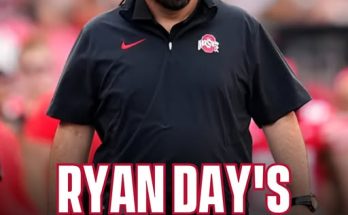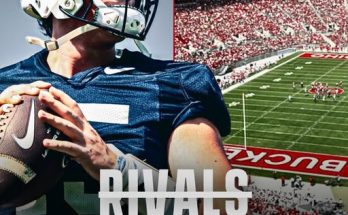The End of an Era: Matt Eberflus Takes Over as Cowboys’ Defense Leader, Mike Zimmer’s Coaching Career Comes to an End
The NFL is a league defined by change. Every year, teams shuffle players, revamp strategies, and seek new leadership to ensure they remain competitive. However, some shifts are more significant than others, marking the end of an era. One such moment occurred in 2025 when Matt Eberflus officially took over as the defensive coordinator for the Dallas Cowboys, while long-time coach Mike Zimmer decided to step away from the game, bringing a storied coaching career to a close. For both coaches, this transition would represent a pivotal moment in their careers, shaped by legacy, evolution, and the changing tides of the NFL.
Mike Zimmer’s Legacy
Mike Zimmer’s name is synonymous with defensive prowess. His career as an NFL coach spanned decades, and his impact on the league cannot be overstated. Zimmer’s journey began as a position coach before eventually rising to prominence as a defensive coordinator. His big break came when he was hired as the defensive coordinator for the Cincinnati Bengals in 2008. There, he quickly earned a reputation as one of the most innovative defensive minds in the NFL, leading one of the league’s toughest defenses.
Zimmer’s defense was defined by discipline, aggression, and adaptability. His ability to mix coverages, dial up blitzes, and create turnovers made him one of the most feared defensive coordinators of his time. In 2014, Zimmer was hired as the head coach of the Minnesota Vikings, and his defensive prowess only became more evident as he took on the role of a leader. Under Zimmer’s guidance, the Vikings developed one of the league’s most formidable defenses, routinely ranking among the NFL’s best.
But Zimmer’s impact wasn’t just about the stats. His ability to motivate players, demand accountability, and create a culture of toughness defined his leadership style. He had an innate ability to get the best out of his players, particularly on the defensive side of the ball. Veterans like Harrison Smith, Everson Griffen, and Danielle Hunter thrived under Zimmer’s coaching, and his defenses became known for their ability to pressure quarterbacks and create turnovers. Zimmer’s ability to develop defensive talent and transform it into elite units earned him respect across the league.
Zimmer’s tenure in Minnesota was not without its challenges. Despite several successful seasons and playoff appearances, the Vikings never managed to break through to a Super Bowl, and they fell short in crucial moments. The inability to consistently contend for a championship in a competitive NFC left many wondering if Zimmer’s time with the Vikings had run its course.
Zimmer’s final years with the Vikings were marked by disappointing results, and in 2024, he made the difficult decision to step away from the NFL, signaling the end of a career that had seen him rise from a defensive backs coach to one of the most respected head coaches in the league. His retirement brought with it a sense of finality, as the NFL and its fans said goodbye to one of the game’s most influential defensive minds.
Matt Eberflus: The Next Generation of Defensive Leadership
When Mike Zimmer made the decision to retire, the Dallas Cowboys were left with a critical need for a new defensive leader. Enter Matt Eberflus, the rising star of defensive coaching. Eberflus had long been a name to watch in NFL coaching circles, known for his high-energy, disciplined defensive schemes. His rise to prominence began in Indianapolis, where he was the defensive coordinator for the Colts from 2018 to 2021.
Eberflus’s defensive philosophy centered around the concept of “Take the Football Away” — a belief that creating turnovers and disrupting the offense was the key to winning games. Under his leadership, the Colts defense became known for its ball-hawking mentality and relentless pursuit of the quarterback. Eberflus’s ability to develop young talent, such as linebacker Darius Leonard and defensive lineman DeForest Buckner, helped solidify his reputation as one of the top defensive minds in the game.
The Colts defense under Eberflus consistently ranked among the league’s best, with a focus on both stopping the run and creating pressure on the quarterback. The defense was balanced, with Eberflus deploying a 4-3 scheme that allowed players to be aggressive while also maintaining gap discipline and integrity. His success in Indianapolis made him an obvious candidate for any team seeking a new defensive coordinator, and when the opportunity arose with the Cowboys, Eberflus was ready to take on the challenge.
Eberflus’s arrival in Dallas marked a new chapter for the Cowboys’ defense, a unit that had shown flashes of greatness but lacked the consistency and discipline to elevate them to the top of the NFL rankings. Under defensive coordinator Dan Quinn, the Cowboys had made strides, particularly in the pass rush, but the unit still had room for growth. Eberflus’s emphasis on creating turnovers, staying disciplined, and playing fast fit perfectly with the Cowboys’ roster, which boasted playmakers such as Micah Parsons, Trevon Diggs, and DeMarcus Lawrence.
Eberflus was brought in to continue the Cowboys’ defensive evolution and bring the same kind of consistency to Dallas that he had demonstrated in Indianapolis. He quickly became known for his meticulous preparation, his ability to create complex defensive schemes, and his focus on high-effort, physical play. It wasn’t long before Eberflus had his fingerprints all over the Cowboys’ defense, molding them into a more aggressive, turnover-hungry unit that was capable of taking over games.
The Transition: Zimmer to Eberflus
The transition from Mike Zimmer to Matt Eberflus represented a significant shift in coaching philosophy. Zimmer had built his reputation on a defense that relied heavily on veteran leadership, discipline, and a stout front seven. He valued stopping the run and controlling the line of scrimmage. Zimmer’s defenses were built to be physical and suffocating, often utilizing a variety of zone coverages and blitz packages to confuse opposing offenses.
In contrast, Eberflus brought a more modern approach to the table, one that focused on versatility, adaptability, and playmaking. While Zimmer’s defenses were grounded in traditional concepts, Eberflus introduced a more aggressive, risk-taking mindset that emphasized turnovers and creating chaos. Eberflus’s scheme often placed a premium on attacking the quarterback, forcing him to make quick decisions under duress. His defenses were fast, fluid, and built to capitalize on mistakes.
Despite their differences in style, there were similarities between the two coaches’ approaches. Both Zimmer and Eberflus valued toughness, effort, and discipline. They both emphasized the importance of coaching up players to perform at their best, no matter their role on the defense. Both coaches also excelled at developing young talent, allowing them to flourish within their systems.
For the Cowboys, the change represented an exciting opportunity. With a roster that included some of the NFL’s most dynamic defensive players, the potential for success under Eberflus was immense. The combination of veterans like Lawrence and young stars like Parsons created a dangerous mix that could disrupt offenses in ways that few teams could match. The move to bring Eberflus into the fold was a testament to the Cowboys’ commitment to building a defense that could contend for championships in the years to come.
The Legacy of Zimmer
Mike Zimmer’s retirement left a void in the NFL that would not be easily filled. His legacy as a defensive mastermind would be remembered not only for his on-field accomplishments but also for the way he impacted the coaching community. Zimmer’s influence could be seen in the number of coaches who had worked under him and gone on to find success in their own right. Many of Zimmer’s former assistants, including Eberflus, continued to spread his philosophy and adapt it to their own coaching styles.
Zimmer was also a mentor to many players, known for his no-nonsense approach and his ability to get the best out of his talent. His attention to detail and his tireless work ethic set an example for coaches and players alike. While his tenure as a head coach might have been defined by his inability to capture a Super Bowl title, Zimmer’s impact on the NFL will be felt for years to come.
Eberflus’s Opportunity
For Matt Eberflus, taking over the Cowboys’ defense was both a challenge and an opportunity. With an elite defensive roster and the potential to develop a unit that could dominate the league, Eberflus had the chance to build his own legacy in Dallas. The pressure was on to continue the team’s upward trajectory and bring a level of consistency that had eluded them in recent years.
Eberflus was known for his attention to detail and his ability to adjust on the fly, characteristics that made him a perfect fit for a defense that required both creativity and discipline. Under his leadership, the Cowboys had the potential to become one of the most feared defensive units in the NFL — a defense that could lead them to the Super Bowl and cement Eberflus’s place as one of the league’s top defensive minds.
Conclusion
The year 2025 marked the end of an era for both Mike Zimmer and the Dallas Cowboys. Zimmer’s decision to retire closed the chapter on a legendary coaching career that had impacted the NFL for over 30 years. Meanwhile, the Cowboys’ decision to hand the defensive reins over to Matt Eberflus signaled the beginning of a new era for the franchise. With his aggressive, turnover-focused approach, Eberflus had the potential to elevate the Cowboys’ defense to new heights. As Zimmer’s legacy lived on in the players and coaches he mentored, Eberflus’s future was just beginning — and with it, the hope of a new defensive dynasty in Dallas.



